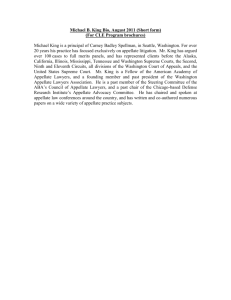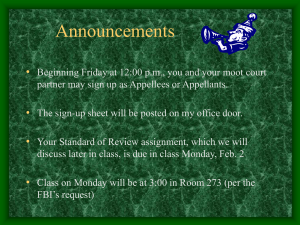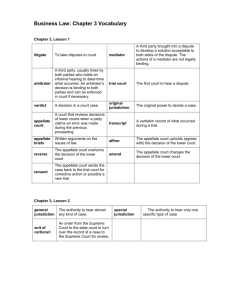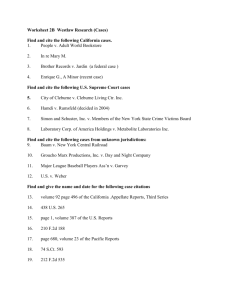View as DOC - Post & Schell, PC
advertisement
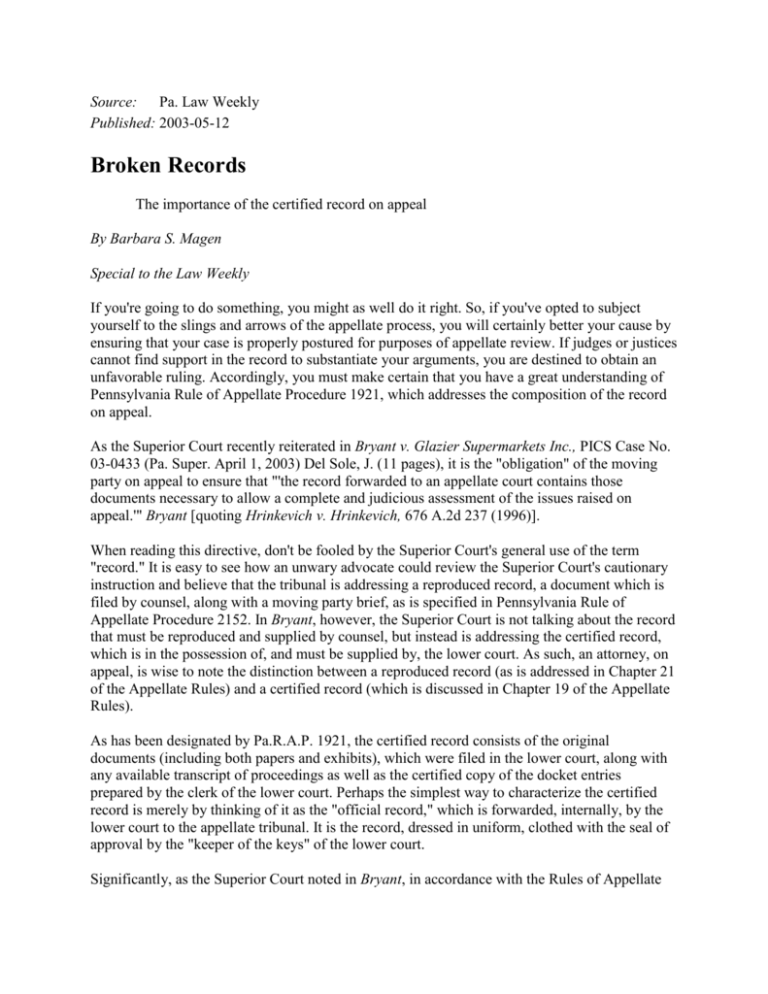
Source: Pa. Law Weekly Published: 2003-05-12 Broken Records The importance of the certified record on appeal By Barbara S. Magen Special to the Law Weekly If you're going to do something, you might as well do it right. So, if you've opted to subject yourself to the slings and arrows of the appellate process, you will certainly better your cause by ensuring that your case is properly postured for purposes of appellate review. If judges or justices cannot find support in the record to substantiate your arguments, you are destined to obtain an unfavorable ruling. Accordingly, you must make certain that you have a great understanding of Pennsylvania Rule of Appellate Procedure 1921, which addresses the composition of the record on appeal. As the Superior Court recently reiterated in Bryant v. Glazier Supermarkets Inc., PICS Case No. 03-0433 (Pa. Super. April 1, 2003) Del Sole, J. (11 pages), it is the "obligation" of the moving party on appeal to ensure that "'the record forwarded to an appellate court contains those documents necessary to allow a complete and judicious assessment of the issues raised on appeal.'" Bryant [quoting Hrinkevich v. Hrinkevich, 676 A.2d 237 (1996)]. When reading this directive, don't be fooled by the Superior Court's general use of the term "record." It is easy to see how an unwary advocate could review the Superior Court's cautionary instruction and believe that the tribunal is addressing a reproduced record, a document which is filed by counsel, along with a moving party brief, as is specified in Pennsylvania Rule of Appellate Procedure 2152. In Bryant, however, the Superior Court is not talking about the record that must be reproduced and supplied by counsel, but instead is addressing the certified record, which is in the possession of, and must be supplied by, the lower court. As such, an attorney, on appeal, is wise to note the distinction between a reproduced record (as is addressed in Chapter 21 of the Appellate Rules) and a certified record (which is discussed in Chapter 19 of the Appellate Rules). As has been designated by Pa.R.A.P. 1921, the certified record consists of the original documents (including both papers and exhibits), which were filed in the lower court, along with any available transcript of proceedings as well as the certified copy of the docket entries prepared by the clerk of the lower court. Perhaps the simplest way to characterize the certified record is merely by thinking of it as the "official record," which is forwarded, internally, by the lower court to the appellate tribunal. It is the record, dressed in uniform, clothed with the seal of approval by the "keeper of the keys" of the lower court. Significantly, as the Superior Court noted in Bryant, in accordance with the Rules of Appellate Procedure, only those documents that are contained within the certified record may be considered by an appellate court. As the tribunal declared in Bennyhoff v. Pappert, 2001 Pa. Super. 365, 790 A.2d 313 (2001), "for purposes of appellate review, what is not of record does not exist." Any material that fails to be part of the "official record" forwarded to the appellate tribunal, from the lower court, is considered to be a nullity, a rabbit vanished from the hat. This has great significance since, as a general rule of thumb, an appellate court will refuse to consider issues raised by the parties if the certified record fails to include those portions of the original, underlying record needed to scrutinize the questions presented on appeal. Therefore, if the certified record does not provide counsel with a proper foundation on which to base, and to prove, allegations of appellate error, appellate counsel will essentially be volunteering (whether consciously or not) to subject themselves to the harsh, unforgiving doctrine of waiver. In light of the appellate courts' strict adherence to Rule 1921, it should not be a surprise that deficiencies in a certified record cannot be fixed by merely including, or quoting from, the missing documents in a brief or in an accompanying reproduced record. Documents that are "missing in action" from a certified record cannot magically re-appear in some other form sufficient to substantiate appellate allegations of error. Since a court must rely solely on the contents of the "official record," it is natural to wonder what an attorney can do to ensure that the lower court clerk is transferring a full, certified record to the appellate tribunal in furtherance of a meaningful appellate review. In this regard, it is notable that the burden to ensure that a complete record is lodged with an appellate court falls on the shoulders not of the lower court clerk, but rather on the moving party on appeal. Hence, when pursuing an appeal, counsel should arrange with the clerk of the lower court to visit the clerk's office to review, and to evaluate, the record before it is forwarded to the appellate tribunal. Thereafter, the wisest attorney will perform follow-up in the nature of a later visit to the location where the records are kept by the appellate tribunal to make certain that all of the necessary materials have been received from the lower court. In this way, counsel can definitely determine, and can have peace of mind knowing, that all documents are safely resting within the confines of the appellate court. Of course, a question remains as to what can be done if a journey is made to an appellate court, and it is found that important materials are mysteriously missing from the certified record. In this circumstance, counsel may file an immediate motion with the appellate court requesting that the record be remanded so that the lower court can supplement the record to add the absent materials. Likewise, counsel may also ask the appellate tribunal to retain jurisdiction over the appeal but to direct that the lower court rectify the errors in the certified record by, within a finite period of time, forwarding the inadvertently omitted documents to the appellate court. Upon taking these actions, counsel will likely find that the courts are very amenable to allowing these corrections to be made considering the consequence if a material document is left out of the certified record. No one should underestimate the worth and the necessity of rooting an appeal in a full and complete "official record." It is simply one of the steps that must be taken along the road to winning an appeal. Certified records are not made to be broken.
